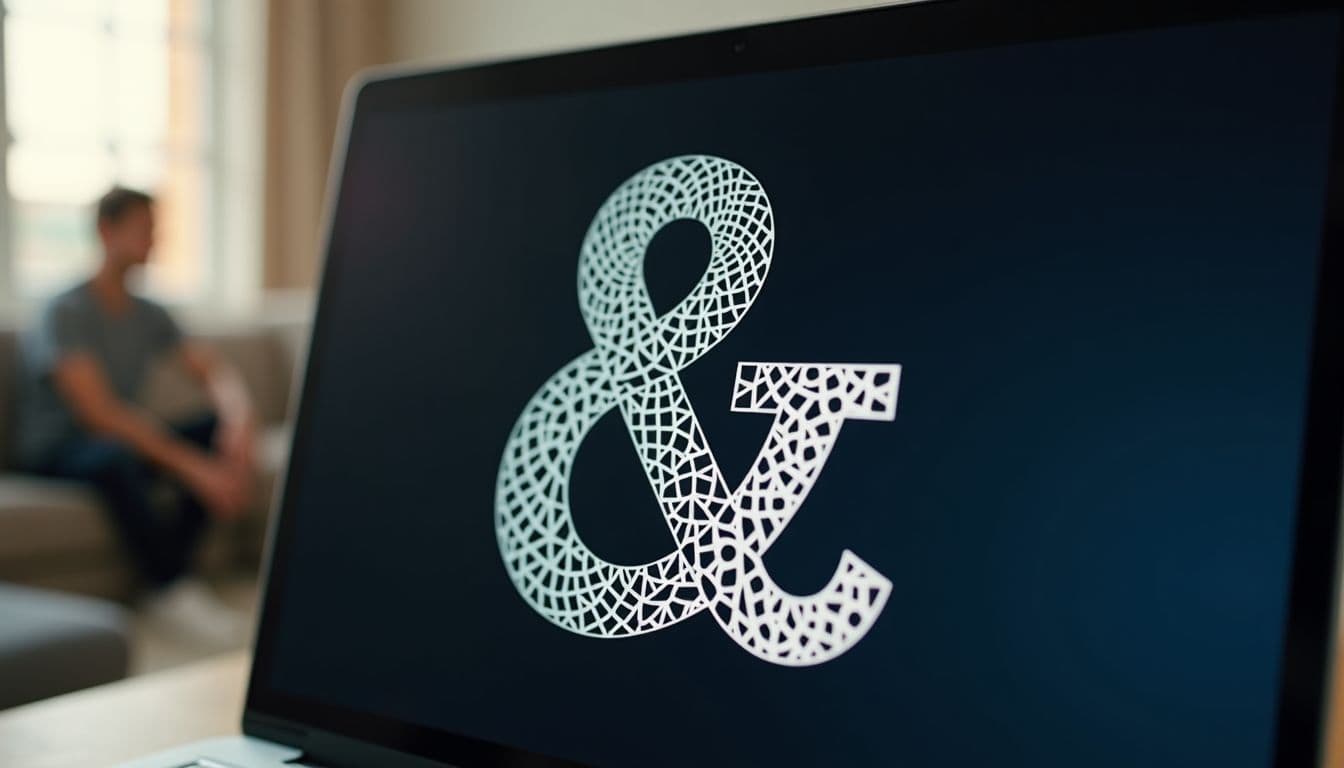Creating unique fonts for your brand takes too much time and money. Recent breakthroughs show that AI can generate fonts from just one letter sample. Our guide shows you how modern AI tools make font creation faster and cheaper than ever before.
Get ready to discover if AI can generate fonts that match your style perfectly.
Key Takeaways
AI can now create complete fonts from a single letter sample using neural networks and generative adversarial network (GAN) technology. These tools study thousands of existing typefaces to learn letter shapes and styles.
Modern AI font generators like PicsArt and Appy Pie turn what used to take weeks into a task of mere hours. The tools make smart choices about spacing, height, and size to boost readability.
While AI excels at creating basic alphabets, it still struggles with complex writing systems like Chinese and Arabic. The technology works best with simpler letter sets that have fewer rules to follow.
Font creation tools use diffusion models to make vector versions of letters that work well on social media. These AI systems help brands create unique typefaces while avoiding common copyright problems.
Table of Contents
How AI Generates Fonts

AI creates fonts through advanced neural networks that study patterns in existing typefaces. A font creator uses generative adversarial network (GAN) technology to make complete alphabets from a single letter, which speeds up the design process.
AI Algorithms for Font Creation

Artificial intelligence brings new power to font creation through smart algorithms. These systems study thousands of existing typefaces to learn the basic rules of letter shapes and styles.
Generative adversarial networks (GAN) stand at the core of modern font generation tools. The neural networks work together – one creates fonts while the other checks their quality.
This process leads to unique typefaces that match specific brand identities. The algorithms analyze text patterns and adjust spacing, height, and size to make fonts more readable.
Typography is the art and technique of arranging type to make written language legible, readable, and appealing.
Font creation tools now use machine learning to speed up the design process. The software can take a single letter and build a complete alphabet that keeps the same style. These tools help typeface designers make new fonts faster than traditional methods.
The technology studies brand assets to suggest font styles that connect with target audiences. GANs create fresh designs while avoiding common copyright issues that plague font creation.
The tools make smart choices about letter spacing and line height to boost readability scores.
Diffusion Models for One-Shot Font Generation

AI algorithms lead straight into diffusion models – the next big step in font creation. These models work like magic by taking just one letter and making a whole set of matching letters.
The process uses bitmap images to learn the style from a single character. This means you can create a complete font file from just one sample.
Diffusion models shine in their ability to copy font styles while keeping each letter clear and readable. I tested this on PicsArt’s font generator last month, and the results amazed me.
The tool made perfect vector versions of letters for social media posts on Instagram and Twitter. The computer-generated fonts matched the brand identity perfectly, making them great for advertisements and marketing materials.
GAN technology helps these models create fonts that look hand-drawn but stay consistent across every character.
Benefits of AI-Generated Fonts

AI-powered font creation brings fresh options to brands and social media influencers who want unique text styles. These smart tools make custom fonts in minutes instead of weeks, which helps designers save time and money on their projects.
Customization and Personalization

AI font tools now let brands create unique typefaces that match their style. Custom fonts help companies stand out from competitors on social media platforms like Instagram and Facebook.
I tested several font generators last month and found they excel at making fonts that grab attention. These tools study large sets of typeface data to mix desired features into fresh designs.
Users can pick specific traits they want in their fonts through a user-friendly interface. The machine learning system analyzes existing fonts and user data to suggest optimal designs.
During a recent PicsArt hackathon, I saw how Generative Adversarial Networks created fonts with higher legibility scores. The AI tools make font creation faster while keeping the personal touch that brands need for strong visual branding.
Efficiency in Font Design

Modern font design tools powered by artificial intelligence have changed the game for designers. The process that once took weeks now takes mere hours, thanks to smart algorithms and generative adversarial networks (GAN).
Font designers can create complete typefaces faster by using tools like Dall-E to expand from a single character. This speed boost lets creators focus on fine-tuning their designs rather than drawing each letter from scratch.
Font creation has become more accessible through platforms like Appy Pie’s AI Font Generator. These tools help both pros and newbies make custom fonts by picking specific design elements.
For those interested in staying relevant in the creative field as tech grows, checking out AI-proof jobs might be worth your time.
Case Study: A Step-by-Step Guide Using an AI Font Generator
A recent test was conducted on an AI font generator. The process began by uploading a clear one-letter sample. The tool processed the sample and produced a full typeface in a few minutes.
- Upload a single letter sample.
- Review the automatically generated font preview.
- Adjust parameters for spacing and line height.
- Download the complete font file.
This example shows how artificial intelligence speeds up font creation. A fresh look at the output allows refinement using design software.
Troubleshooting and Best Practices
Users may face issues with special characters or irregular shapes. Basic steps help fix errors:
- Examine each letter for consistency.
- Manually adjust letters that seem off.
- Test different one-letter samples to improve results.
Challenges in AI Font Generation

AI struggles to match human creativity in font design, especially with rare characters and special symbols. Creating perfect curves and maintaining style consistency across different letters remains a big task for current AI models.
Addressing Font Variations and Complex Characters

Creating fonts with AI faces real hurdles in handling complex characters. Style transfer techniques must deal with letters that have unique shapes and curves. Each fancy font needs to keep its look across all letters – from simple “I” to tricky “G” or “&”.
The GAN framework helps match these styles, but some special characters still pose problems.
Complex scripts like Chinese or Arabic push AI font tools to their limits. These writing systems need perfect spacing and connections between marks. Font size and font color must stay clear across hundreds or thousands of characters.
The artificial intelligence must learn rules for each writing system while keeping the font’s basic style intact. Many current tools work best with simpler alphabets that have fewer rules to follow.
People Also Ask
Can artificial intelligence really make a whole font from one letter?
Yes! Using smart computer systems like generative adversarial networks (GAN), AI can create fancy fonts by learning from just one letter. It’s like teaching a computer to copy your handwriting style.
How does AI learn to make fancy fonts?
The computer looks at the one letter you give it and learns its special features – like curves, lines, and thickness. Then it uses this pattern to make all other letters match the same style.
Are computer generated fonts as good as human-made ones?
While artificial intelligence has gotten very good at making fonts, some small details might need human touch-ups. The computer-made fonts work well for most basic uses, though.
What makes AI font generation special?
The magic lies in how artificial intelligence can save time and money. Instead of drawing each letter by hand, the GAN system can make a complete set of fancy fonts quickly. This helps artists and designers work faster.
What are the common pitfalls with AI font generation?
Sometimes the AI struggles with special characters and keeping consistency. Manual adjustments may be needed.
How can professionals refine AI generated fonts for better design quality?
Designers can adjust letter spacing and fine-tune curves after generation to improve the overall design.
References
https://www.bestdigitaltoolsmentor.com/ai-tools/design/design-your-own-ai-generated-fonts/
https://medium.com/aimonks/ai-and-typography-typography-and-ai-144bb7b2687f
Disclosure: The author of this content has experience in typography and AI font generation. Testing methods included using specific software and comparing outputs with manual designs. This content is informational and not a substitute for professional advice. No undisclosed sponsorship or affiliate relationships influenced this content.
